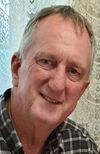Steve Cook: My Story in Art - Part One
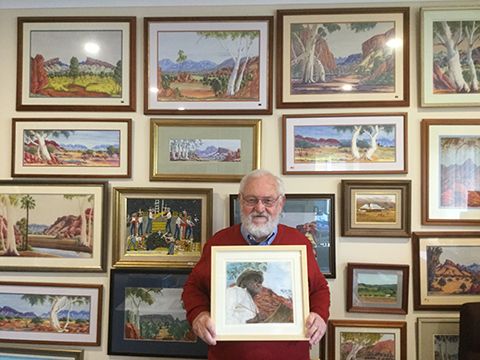
One of the main purposes in producing the AnArt4Life blog is to showcase stories from lovers of art covering the multitude of mediums, styles, types of art and hoping to reveal what makes a person take up collecting or producing art.
Over the six years since the birth of the AnArt4Life blog we have introduced you to some amazing people - artists, art collectors, aesthetes and supporters - all passionate about living in a world where art has pride of place.
Today I want to introduce you to H. Steve Cook from Victor Harbor in South Australia - who fits snuggly into our art enthusiast mould but I will let Steve tell you all about his art story which commences with him acknowledging the art teacher who encouraged and developed his love of art.
My name is Steve Cook and my interest in art started at Minlaton High School in South Australia in 1963. My secondary school art teacher was friendly, efficient, and encouraging. Her name is Marie Parsons and since leaving teaching many years ago, she has become an accomplished professional artist. Marie's enthusiasm has rubbed off on the next two generations because both her daughter Allyson Parsons, and grandson Henry Cockington are professional artists. You can view some works by Marie and Allyson by clicking here and Henry by clicking here.
Marie's encouragement had a huge bearing on my appreciation of art. In 1965, my mother was given several Hermannsburg paintings in lieu of payment of a debt. Mum didn't have a true appreciation of them and basically gave them away. I was 15 at the time and asked Mum what she'd done with them. I was shocked that she'd given them to family and friends and told her so, there were two left - a Herbert Raberaba and Oscar Namatjira - and she said Well dear, if you liked them so much you should have said so, you can have the last two!
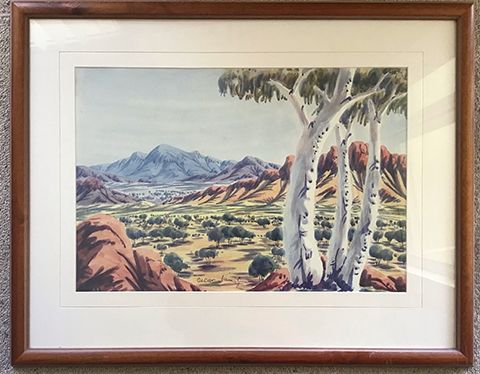
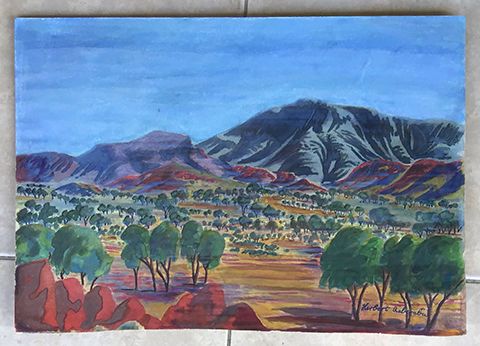
At this point I need to explain a little more about Hermannsburg Paintings for overseas readers of the AnArt4Life blog.
The Hermannsburg School of Painters refers to the group of artists who followed after Albert Namatjira, whose watercolour paintings brought the beauty of the West MacDonnell Ranges to the attention of all Australians in the middle of the 20th century. Hermannsburg was Albert Namatjira’s home and the birthplace of several generations of artists who continued the legacy established by Albert.1
Follow this link to read more about the Hermannsburg School of Painters and for more specific information and to see some of the works of Albert Namatjira please click here.
And that started my lifetime love for the Hermannsburg school of aboriginal water colour paintings. Having said that, over the next 50 years I collected an eclectic gallery of paintings of many genres, and many subjects. These were my working years and whenever I had a few bob to spare I would invest in my collection.
I didn't specifically concentrate on Hermannsburg paintings but managed to collect quite a few here and there. My first Wenten Rubuntja was bought from a gallery in Broken Hill circa 1970. It cost a mere $30. These days similar paintings by the same artist bring anywhere from $400 to $1200.
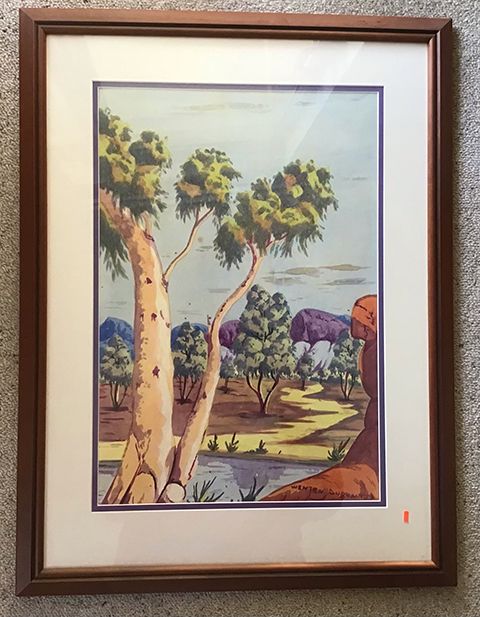
To read more about Wenten Rubuntja (1926-2005) I recommend you seek out the book The town grew up dancing. The Life and art of Wenten Rubuntja from your library or on-line to purchase. And follow this link to read the bio of Wenten Rubuntja.
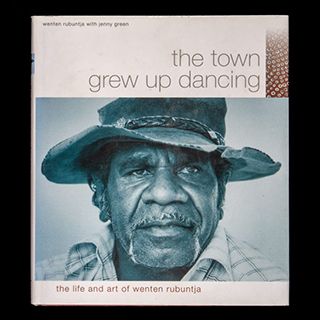
I chose semi-retirement in 1995 and with this came more disposable income ... AND, eBay. With eBay came opportunity to bid online for whatever I could afford and I was soon picking up more Hermannsburg paintings mostly for reasonable prices. I also further developed my collection to include paraphernalia. Anything to do with Albert Namatjira in particular (books, posters, coasters, postcards, exhibition catalogues etc etc), but also other Hermannsgurg artists. Like all collections, mine just grew and grew and thank goodness I have Gill, my wonderful, patient, and understanding wife.
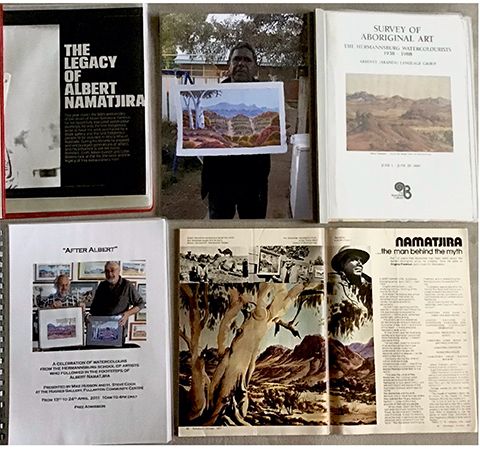
When we moved to the beautiful Fleurieu Peninsula in South Australia, we had to double the size of our home to incorporate my gallery and house my collections. By now I was fully retired.
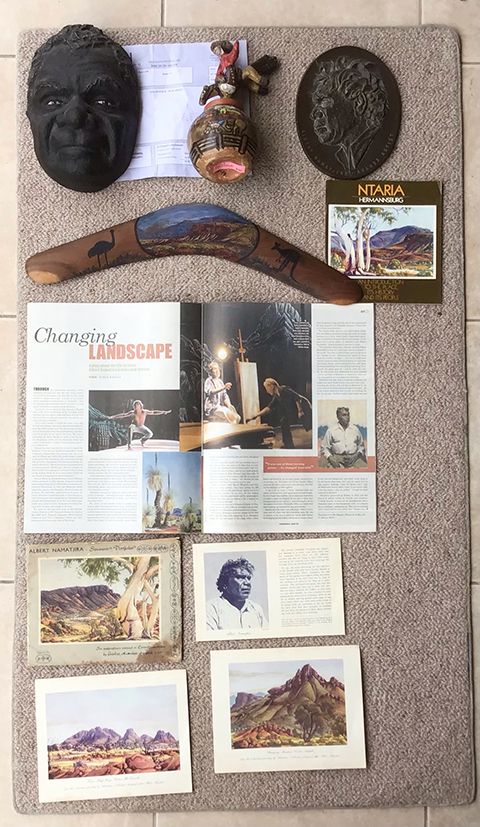
Every work of art has a story and if formalised and available it is called a provenance which adds to its value. If you are starting a collection make sure that, where you can, know where the item you are adding to your collection has been. It's a little like checking out where your teenage children have been and who they have been associating with. Like teenagers - occasionally a painting might have had an association with someone not so honest and even perhaps with criminal intent.
The provenance of a painting authenticates that the claimed artist did in fact produce this work. I am sure you are all very familiar with the BBC documentary series Fake or Fortune where from time to time forgeries and other such undesirable actions are discovered.
Below is a Douglas Kwaalpe Abbott painting. It's a wonderful painting but like most of them, they aren't titled, or have generic titles such as "West MacDonnell Ranges". It is a beautiful example of Hermannsburg watercolour. Mind you, unlike many, it doesn't have the gum tree on right or left and I love it.
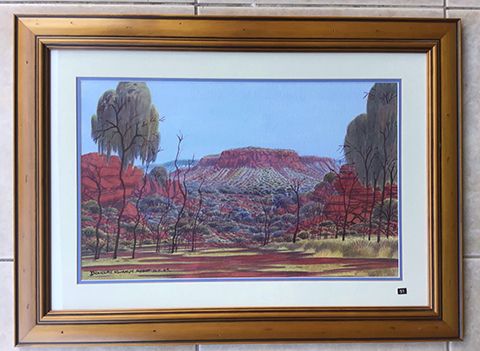
And here is a photo of the back of the painting showing you the provenance I try to provide for each of my paintings so that what I know about the painting's journey is documentated for the future.
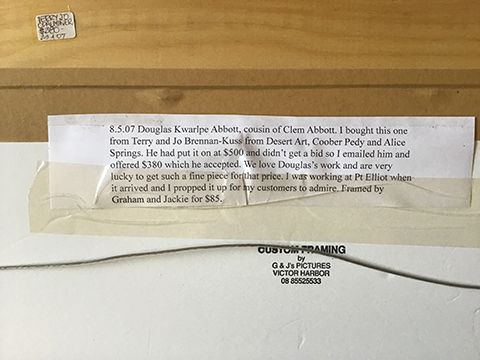
I have been a collector of Hermannsburg art pretty much since I was 15 (now 73) but didn't have spare money until I retired. Having said that, there was a wonderful little old lady, Hazel Watts, who had a gallery at Tanunda in the Barossa Valley where I lived for several years and I used to regularly buy from her. I would put a deposit down on something I liked, then pay it off in fortnightly instalments. Bless her, RIP.
One day I saw an advert for a Hermannsburg exhibition to be held in Adelaide. Naturally I was excited by this and we made time to visit it. That's when I met my mate Mike Hudson who, like me is a Art enthusiast specialising in Hermannsburg art. But more about this tomorrow when I continue my Story in Art on the AnArt4Life blog.
© Thank you to Steve Cook who provided most of the information used in this post and who kindly gave permission for the images of his collection and personal works to be shared on AnArt4Life.
A special thanks also to Gillian Kay Cook who took most of the photographs and gave permission for them to be used in this post.
Tomorrow Steve will tell us a little more about another aspect on art which takes up a little extra of his time.
Footnote
▲This is a photo of Steve holding an original pastel by Rex Battarbee of Albert painting plein air. The paintings in the background from top are Wenten Rubuntja, Richard Forrester, Clem Abbott. Next row, Therese Ryder, Peter Tjutjatja Taylor, and another Therese Ryder, 3rd row, Walter Ebatarinja (with the palm tree), Sam Byrne, (Broken Hill naive artist whose works I love but I've only got this one) one my left shoulder is NSW bush artist Bill O'Shae under Bill is a lovely little oil by an unknown artist, cost me $1 but is unsigned. ... Bottom row is Therese Ryder, and partly hidden behind my elbow is Ian Wassa.
Late Mail
A very warm welcome to L.C. in Australia who has come aboard to join the AnArt4Life blog community. And a very special thank you to all those subscribers and followers who have been with us on our art journey which is approaching its 6th birthday in Novemeber.
That's right - the team who are behind the blog have been sending out a post about art every morning for six years. We are very proud of our effort and the amazing people who follow us and share in our love of art in all its manifestations.
Credit
1. japingkaaboriginalart.com
